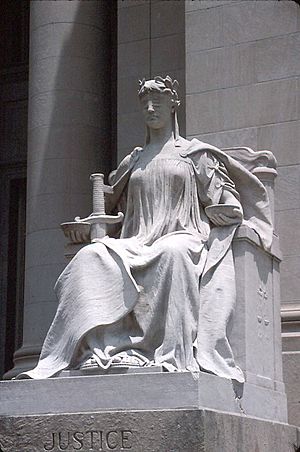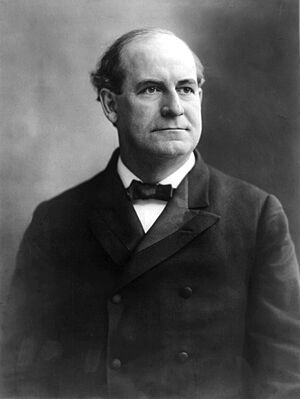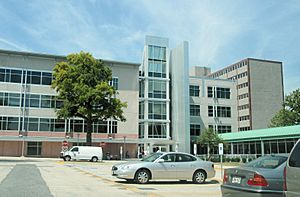Social policy facts for kids
Social policy is like a big plan or set of actions that governments or other groups create to make society better. It's all about improving how people live and helping everyone have a good quality of life.
These plans often look at things like how people get the help they need, like healthcare, education, and support when they're struggling. Social policy aims to make sure that resources and opportunities are shared fairly among everyone in a community. It tries to solve big problems that affect many people.
History of Social Policy
Social policy as we know it today started to take shape in the 1940s in Britain, thanks to a person named Richard Titmuss. He thought a lot about how society helps its members, especially when markets don't provide everything people need. He believed that everyone should have access to important services.
But ideas about helping people are much older!
- Ancient Rome: Around 123 BC, the Romans had something called Cura Annonae, which was a way to give grain to people who needed it. This helped make sure everyone had food.
- Early Islam: In the 6th century, the second leader of Islam, Umar ibn al-Khattāb, used government money to create pensions, income support, and help for children and non-Muslims. This was an early form of social support.
- English Poor Laws: Later, in England, laws were made to help people who were very poor and to reduce crime. These laws influenced systems like the Speenhamland system, which was one of the first modern social programs.
- Industrial Revolution: After factories and cities grew, many people lived in tough conditions. Think of the crowded, dirty areas in Victorian Britain. People like Charles Booth studied these problems. Their work pushed governments to make changes, like improving conditions for the poor.
- Modern Welfare States: In the 19th century, Otto von Bismarck in Germany created early social insurance programs. In the United States, the New Deal programs in the 1930s helped people during the Great Depression. In Britain, the Beveridge Report and the creation of the National Health Service in the 1940s provided healthcare for everyone. These examples led to two main ways countries provide social help: the German "Bismarckian" way and the British "Beveridgean" way.
Today, social policy is very complex. It's shaped by local governments, national governments, and even international groups like the European Union.
Types of Social Policy
Social policy tries to make life better for people and meet their basic needs. It covers many important areas:
- Wellbeing and Welfare: Helping people live healthy and happy lives.
- Poverty Reduction: Working to reduce the number of people living in poverty.
- Social Security: Providing support for people who are retired, disabled, or unemployed.
- Justice: Making sure laws are fair and everyone is treated equally.
- Housing: Helping people find safe and affordable places to live.
- Healthcare: Making sure everyone can get medical care.
- Education: Creating good schools and learning opportunities for all.
- Child Protection: Keeping children safe and healthy.
- Crime and Criminal Justice: Dealing with crime and making sure justice is served.
- Labor Issues: Looking at fair working conditions and jobs.

United States Social Policy
The United States has a unique history with social policy. Early on, it spent a lot of money helping Civil War veterans and their families. However, compared to some other rich countries, the U.S. later spent less on social programs.
Many ideas have shaped American social policy:
- Religious and Philosophical Ideas: Ideas like hard work and self-reliance have influenced how Americans think about helping others.
- Social Darwinism: This idea, which suggests that only the "fittest" survive, also shaped views on capitalism and individual responsibility.
The New Deal A major turning point was President Franklin D. Roosevelt's New Deal in the 1930s. This was a huge set of programs created to help the country recover from the Great Depression. Instead of just giving out money, the New Deal focused on creating jobs and boosting the economy through public projects.
The Great Society Later, in the 1960s, President Lyndon B. Johnson introduced the Great Society programs. He wanted to fight poverty and improve the quality of life for all Americans.
- Healthcare: Programs like Medicare (for older people) and Medicaid (for low-income people) were created to provide health insurance.
- Education: The Great Society also brought in important education laws, like the Elementary and Secondary Education Act of 1965 (ESEA). These laws aimed to improve schools and help students.
Recent Education and Healthcare Changes
- No Child Left Behind Act (NCLB): In 2002, President George W. Bush signed this law. It aimed to improve schools by setting standards and holding schools accountable. However, it faced challenges and was later changed.
- Every Student Succeeds Act (ESSA): This law, passed under President Barack Obama, replaced NCLB. It gave states more control over their education standards.
- Affordable Care Act (ACA): In 2010, President Barack Obama signed the Patient Protection and Affordable Care Act. This law aimed to make health insurance more affordable and available to more Americans.


See also
 In Spanish: Política social para niños
In Spanish: Política social para niños
- Criminology
- Education policy
- Great Society
- Health policy
- Housing policy
- Medicaid
- Medicare
- Social insurance
- Social Security Administration
- Social Security (United States)
- Social theory

